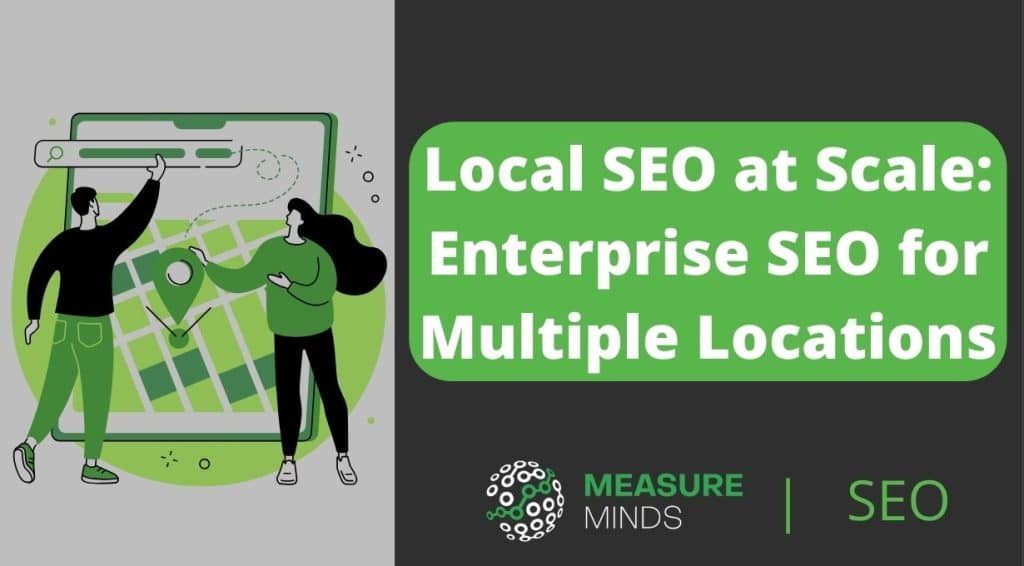
Enterprise Local SEO at Scale: SEO for Multiple Locations
Ultimately, search engine optimisation drives sales. It allows you to rank high on Google for target keywords. Local SEO focuses on keywords in a specific geographic area, typically a single city. It involves optimising your site for local keywords, building relevant links and submitting to high-profile directories with consistent contact information.
For enterprises with multiple locations, the approach becomes more complex. What if you have hundreds, or even thousands of locations you want to rank first for?
This article provides a step-by-step guide to enterprise local SEO for multiple locations from strategy to on-page SEO and link building.
In addition to these steps, you may wish to complete an SEO audit to thoroughly understand any digital marketing issues that are holding back your site.
Introduction to local SEO
Before exploring multi-location SEO, let’s first review the digital marketing steps for a single business location.
Imagine your business as a hidden gem nestled within a bustling digital city. Local SEO is the process which shines a beacon brightly on your website, so visitors find you, and not one of your competitors.
It includes the following steps:
Local on-page SEO
1. Keyword research
Do multilingual keyword research using any of a variety of free or paid keyword research tools available to identify the terms potential clients search for when looking for your business. One term might include “near me”. Where that’s the case, replace “near me” with the name of your city or region for the additional steps.
2. Keyword inclusion
Include the keyword in your Meta Title, H1 title, URL, links, main body of content and footer text. Don’t include it excessively, as keyword stuffing is heavily penalised by Google. Instead, include semantic keywords. Semrush and ClearScope both provide tools for this, alternatively, ask an AI tool to suggest potential semantic keyword variants.
3. Local content
As part of a local SEO campaign, you will also need a local SEO content strategy, focusing on creating meaningful content for your target audience.
4. Conversion rate optimisation
Write engaging content and take steps to optimise your conversion rate. It’s important that visitors not only find your business, but once they arrive, they are motivated to get in touch with you.
5. Mobile-friendly web design
Create an engaging and mobile-friendly web design. A BrightEdge SEO study revealed that 57% of local search traffic is from smartphones and tablets.
Local link building
1. Google Business profile
Claim your Google My Business listing, ensuring you add photos, relevant information and the correct business name, address and phone number (NAP).
2. Directory submission with consistent NAP
Submit your site to any online directories that appear on the first few pages of Google for relevant keywords. These act like road signs, directing potential clients towards your business from multiple sources. Consistency is key, so ensure your NAP (Name, Address, Phone) details are the same in every directory.
Search for local social media pages and share links to your business on there. If pages have a no advertising policy, consider linking to a non-commercial blog post instead, or search for questions like, “Can anyone recommend a…”.
For B2B social media, focus on LinkedIn, for B2C, focus on Facebook. Instagram is useful for both, particularly if you eye-catching images to share.
4. Request reviews
Request reviews from clients and include links to your Google business profile and any major directories which regularly appear on the first page for important keywords. Ask for feedback every time you complete work and whenever anyone leaves you positive feedback, automate it to send an email requesting a review on Google, or on industry-specific review sites.
5. Guest posts
Build editorial backlinks by submitting guest posts to relevant online blogs, or contributing to articles written by journalists.
Enterprise SEO strategy
Local SEO for enterprises is an extension of the above process, except it’s not just a single outlet you want to guide clients to, but a network of interconnected destinations, often spanning the globe.
Local SEO for multiple locations
For a large enterprise website with thousands of pages, SEO can be defined by five core aspects:
- Choosing key performance indicators to track your success. This includes defining your priority destinations, as unless you have vast resources, it won’t be possible to do in-depth optimisation for all your store locations.
- Configuring default options to optimise multiple pages simultaneously as far as possible.
- Technical SEO to improve page speed, make your site user-friendly and comply with SEO best practices.
- Creating and optimising content for your most important landing pages.
- Building strong backlinks to your home page and other globally relevant pages and local links to individual pages for priority cities.

In the ever-expanding digital realm, mastering these five aspects of SEO ensures potential clients find your local businesses, no matter where they hail from. Complete the following steps:
How to avoid getting a Google penalty
Certain strategies will get you penalised by Google and must be avoided. The first step is therefore to NOT do any of the following:
1. Don’t add virtual offices on Google Maps
These are against Google’s policy and you risk your whole digital map placements being wiped, along with any reviews you’ve accumulated by using this strategy.
2. Avoid duplicate content
You also can’t simply use the same content for all your business locations, it needs to be tailored for each. Note, translations don’t count as duplicate content.
3. Avoid spammy link building strategies
Google is very good at detecting spammy link building. If any SEO agency offers you a hundred backlinks overnight, run for the hills. Quality wins over quantity when it comes to link building.
Choose key performance indicators (KPIs)
Configure Google Analytics 4 to track conversions. Use estimated income from different sections to identify your potential income per conversion. This will give you a clear picture of your return on investment and allow you to more accurately judge the value of specific landing pages and keywords.

Determine your KPIs, which might include:
- Rankings for specific keywords.
- Traffic to important landing pages.
- Traffic on a country-by-country basis.
- Conversion rate per business section.
- Overall increase in income.
- Return on investment from your SEO campaign.
Identify globally relevant keywords
Start by completing keyword research irrespective of location. For example, with SEO for a financial services company, keywords might include:
- Budgeting
- Tax return services
- Financial planning
- Etc.
Ensure these keywords are used naturally within your menu links and in some of your URLs. For your highest profit services, it’s also worth including them in your footer text or tagline.
When translating your site, create a keyword glossary identifying equivalent keywords in different languages. This helps make your translated content optimised as it’s created, rather than needing to do everything after the translation is complete.
Configure default meta titles, descriptions and URLs
The Google search results show your Meta Title, Description and URL. They have a huge impact on both your ranking and click-through rate (CTR). What’s more, of all the SEO elements, they’re one of the easiest to optimise in bulk.
Configure your location-specific service pages to have the following by default:
Meta title:
<Keyword> in <City> | <Brand>
URL:
<City>-<Keyword>
Meta description:
A phrase which includes your unique selling points, the city, and the keyword.
H1:
<Keyword> in <City>
For real estate and travel companies, add <Country> or <State> after <City> in the Meta Title, as these are often included as part of the search string. If in doubt, further keyword research will reveal whether this is important in your industry.
Technical SEO
The larger the site, the more likely that installing a new addon will substantially slow it down. Therefore weigh each decision carefully and monitor the impact your choices have on site speed.
Review elements like your logo or footer images that appear on every page to be sure that they are the right size and fully optimised. Next, prioritise optimising images on your home page and individual landing pages.
Implementing structured data is crucial for large businesses when implementing SEO for multiple locations. By using structured data, enterprises can provide search engines with clear and organised information about each of their destinations, making it easier for search engines to understand and display relevant information to users.
To implement structured data for multiple locations, utilise schema markup. This is a standardised vocabulary recognized by major search engines like Google, Bing, and Yahoo.
Use the Schema Markup Validator & Google Search Console Rich Results Test to test if your schema markup works. If you don’t you could have a negative effect on your site.
Schema markup allows you to tag specific data on different pages or sub-folders with location-specific attributes, such as addresses, phone numbers, opening hours, and even customer reviews.
This improves the accuracy and consistency of information in search results, and increases the chance that you will appear in Google’s local business listings, and other location-based queries.
Master your technical SEO.
Create unique SEO content for multiple locations
While the above steps primarily cover your website as a whole, it’s also necessary to create unique content for individual pages.
Job, property or service listings
For many enterprises, the best way to do this is to create dedicated landing pages for each region with a short introductory text, then listings of relevant internal pages. These might be in the form of:
- Job listings (for job platforms).
- Attractions or accommodation (for travel websites)
- Properties for sale or rent (for real estate listings)
- Individuals offering services (for platforms connecting local service providers to visitors searching for those services, e.g. builders, counselling, private tutors, etc.)
These listings give you unique, relevant content that is specific to each region. Where individuals offer services, or sell something through your site, you can also create a platform so they can add their own text and images, meaning user-generated content will be a significant part of your content.
Local SEO for non-location-specific services
For enterprises providing financial services, or online services of any nature (marketing, online training, legal advice, etc.) it’s more of a challenge to identify how to create unique content for each destination without simply rewriting the same content over and over.
Google’s content SEO policy states, “Google’s automated ranking systems are designed to present helpful, reliable information that’s primarily created to benefit people, not to gain search engine rankings, in the top Search results.”
Rewriting content over and over, but changing the name of the city is exactly the kind of content Google aims to discriminate against. So, how do you rank high for <City> + <Keyword> for these kinds of services?
There are a few SEO strategies that generate consistent results:
Tailor content to local laws
Where the law, specific financial regulation or economic conditions are different in different states or countries, write specific content that takes this into account. For example, you might need to mention tax laws or specific investment opportunities that are relevant to each location.
Incorporate local news or events into your content
This ensures each page has unique content in terms of meaning, not just word choice, and shows you are up-to-date with local events.
Use location-specific case studies, examples, and expertise
Including local success stories, examples within your text and showing profiles of local experts all help make content more relevant to both search engines and site visitors. This can be in both your core service pages and your blog.
Local link building
Local link building is crucial for multi-location enterprises because it enhances your online visibility, credibility, and relevance in various geographical markets.
Links act as the bridges that connect local businesses and communities to your site. Links from high authority sites and popular local social media pages are the largest bridges, driving the most traffic. Not only that, Google treats quality backlinks like word-of-mouth recommendations and they also improve your search engine ranking.
Link building is a time-consuming process and you will gain a higher return on investment prioritising a few key locations, than trying to build backlinks to every possible destination. Start by identifying 10-20 cities or countries with large populations, or where you already have the most customers.
Look for niche social media pages where you can link to your service or blog pages. See if any directories or “top 10 service providers in X” articles rank high in Google for relevant keywords and submit your site to these, preferably with a relevant local URL as the backlink, rather than the home page.
Our enterprise SEO services
For local enterprise SEO for multiple locations, don’t be tempted by old-fashioned or black-hat SEO strategies. Focus on creating relevant content that will appeal to both search engines and visitors. Get in touch to discuss how our SEO services can help you target default SEO factors that can be applied across your whole site quickly and easily, then dive into on-page SEO for individual business locations and pages.
- How to Blend GA4 & UA Data Using BigQuery & Looker Studio - 12/07/2024
- How to do a Google Analytics 4 Audit & Mistakes to Avoid - 10/07/2024
- How to Backup & Visualize GA3 Data for Free - 27/06/2024
Excellent read! Thanks for addressing this topic!